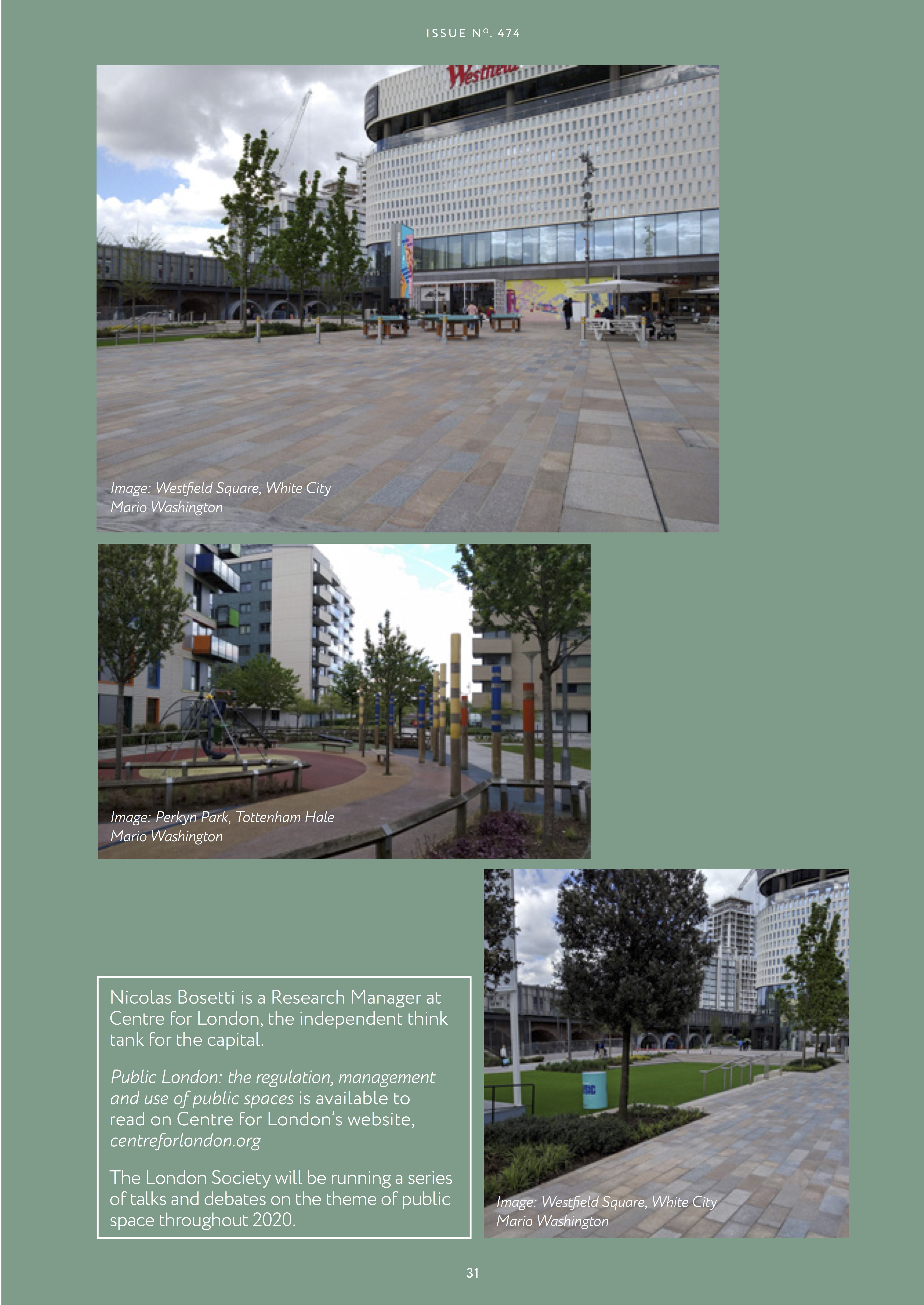Post
JOURNAL 2020 | Opinion: London's Public Spaces
26 Mar 2020
London needs new principles for the management of its public spaces, argues Nicolas Bosetti
Article taken from the 2020 edition of the Journal of The London Society. Find out how to get a print copy of the Journal here - we are still mailing them out even during the lockdown.
Does London know how to manage its public spaces? From music festivals in parks to occupation protests, barbeques and ‘anti-social behaviour,’ there is great potential for dispute over how our public spaces can be used and by whom, especially as the capital’s population grows – by the size of Birmingham’s in the past 10 years. Are we creating the next generation of squares, alleyways and parks that will become where Londoners and visitors like to meet, mix and linger – but also where they can protest, perform or grill food?
I can think of few cities in Europe where there is such a diversity of organisations responsible for the upkeep of public spaces – defined as spaces where the general public has a legal right or permission to be. Local authorities, the Great Estates, non-profit and community-led organisations: much of this diversity is inherited, but our more recent public spaces show our funding and planning decisions at work. For example, the London Plan requires any sizeable development to create new public realm, which landowners can retain and manage. Given the strains highlighted above, how well are London’s public spaces managed – and does it matter whether they are in public or private ownership?
Centre for London conducted a piece of research in 2019 commissioned by the Mayor of London, looking at how London’s newer public spaces operate. To do this, we traced the life of ten public spaces – from the vision behind them to their delivery, their management and their use. We chose spaces reflective of London’s urban fabric: from Paternoster Square by St Paul’s Cathedral a popular lunch spot for City workers and tourists, to Perkyn Park, a neighbourhood park and playground in one of Tottenham Hale’s new housing developments.
We found that the public, private and third sector can all be very capable of creating and maintaining high-spec public spaces. Most of the public spaces we researched looked far from cheap – Westfield Square has a stage for public performances with the same capacity as the O2, Crossrail Place Roof Garden has a canopy to enable the garden to be used all-year round. Both landowners curate a free entertainment programme, and several other space managers were day in, day out, installing pop up playgrounds, deckchairs or picnic tables. Overall, user satisfaction with the spaces we studied was high: users rated their cleanliness, and said they felt safe and welcome using them. Levels of access were good too – most weren’t gated, and those that were had long opening hours, like Ealing Town Square.
However, whilst many recent public spaces are being managed to a high standard, some of our recent public spaces are a little less public than others. In the interest of cleanliness and safety, some commercial landowners appear overcontrolling, regarding the public spaces they manage as an extension of their commercial estate. Despite some managers declaring that “there are no rules to enforce”, we came across restrictions on drinking alcohol, smoking, rough sleeping or canvassing in public spaces – which are likely to deter some groups of users more likely to take part in these activities, and displace them on to other public spaces.
Several spaces – for example Crossrail Place Roof Garden or Paternoster Square – were also heavily policed, with a 24/7 private security presence, which created feelings of insecurity among some users, and led many to doubt whether they were in a public space. Permanent security presence may well be reassuring to some users, but others, more likely to be targeted by day-to-day policing, might feel deterred or harassed.
Does that mean we should forfeit commercial investment in the public realm, and reject privately owned public spaces out of hand as hostile interventions into the city? Centre for London thinks not, though public spaces need to be managed in a way that reflects the interests of all their current and potential users, as well as the smaller group of residents or business tenants who pay maintenance charges.
Our recommendations seek to strike that balance, so London can continue to harness private investment into public spaces, while ensuring greater public accountability and oversight:
- Strip unnecessary regulations: landowners of public space should only be making rules required to protect safety or citizens’ rights to use the space as they wish without causing a nuisance to others.
- If stricter rules are needed, there should be full transparency and greater public oversight, eg lighting of campfires in dense parts of the city
- Soften the security set up for public spaces by promoting their self-management, eg encouraging longer-term business tenancies or installing gardeners/park rangers
In practice, local authorities will need to write these conditions in the agreements they negotiate with developers – or else refuse planning permission. There is no doubt that the Mayor of London will also need to dedicate some resource to their enforcement – perhaps setting up a team to become the city’s public space ombudsman. Applying these principles for good management of our public spaces could go a long way in helping us create a new generation of public spaces loved by all Londoners.
Nicolas Bosetti is a Research Manager at Centre for London, the independent think tank for the capital
Find out more
Public London: the regulation, management and use of public spaces is available to read on Centre for London’s website, centreforlondon.org
